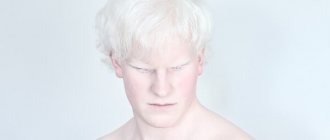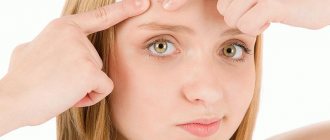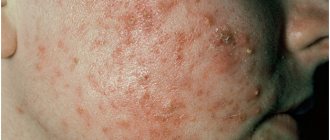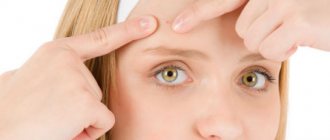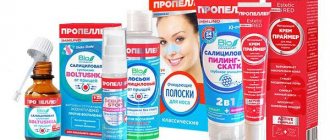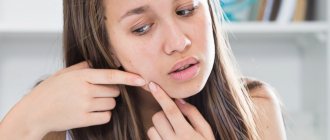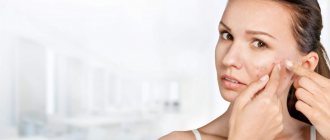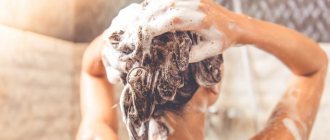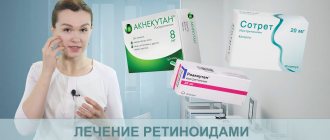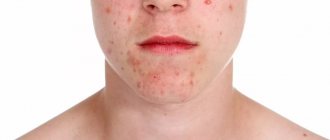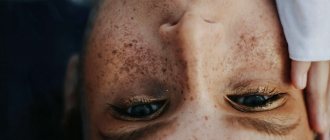Acne (acne) is one of the most common skin diseases in the practice of a dermatologist.
It occurs more often in young people during puberty, but can affect the skin at a more mature age, often leading to the formation of cosmetic defects (spots, scars) and emotional discomfort. According to statistics, acne affects up to 80% of the population aged 12 to 25 years, and approximately 30-40% of people over 25 years of age.
The disease is based on chronic inflammation of the sebaceous glands, resulting from their blockage, increased sebum production (seborrhea) and exposure to the bacteria Propionibacterium acnes.
Where is increased fat content possible?
The content of the article
Problem areas:
- upper back;
- facial part, especially the chin, forehead and cheeks;
- cervical and thoracic parts of the body;
- genitals in both sexes;
- peripapillary zone.
These are the most common and most common, but there may be others. The only places on the body where acne cannot appear are the palms and feet. Due to the too thick and rough layer of the epidermis, incapable of this kind of inflammation.
How do changes in the functioning of the sebaceous glands affect the condition of the skin?
Changes in sebum secretion are one of the factors in the development of acne. Sebocytes in the sebaceous glands synthesize free fatty acids even without the participation of propionibacteria. This makes it likely that aseptic inflammation will develop without the presence of a bacterial component.
With hyperseborrhea, not only the amount of sebum produced changes, but also its composition, in particular, the content of linoleic acid in it decreases. Its deficiency can cause follicular hyperkeratosis40. This is due to the ability of linoleic acid to regulate keratinocyte differentiation10.
Regulation of the level of sebum secretion is also entrusted to hormones. Estrogens suppress, and progesterone and androgens, on the contrary, stimulate the process of sebum production.
Against the background of hyperseborrhea and increased keratinization of the skin, inflammation and blockage of the sebaceous gland channels occurs. Since it becomes impossible for air to get inside them, conditions are created for the proliferation of P. Acnes10.
Causes
- Dry skin;
- Hormonal changes in the whole body;
- Infection;
- Too much sebum production.
In addition to these reasons, there is another factor that was recently established by scientists - heredity.
Let's look at each reason in more detail.
Dry skin
One of the most common reasons. Due to dryness, the skin exfoliates and its particles clog the pores, which causes inflammation. It is very important to consider several points that cause excessive dry skin:
- Age. Over the years, the skin gradually loses many of its important properties, which include moisture retention.
- Environment. Dry and cold air, low humidity, and so on.
- Shower with hot water. Leads to the destruction of the protective layer of the skin.
- Allergic diseases.
- Hygiene products. Using regular soap on sensitive areas of the skin: facial skin, intimate areas, can cause dryness and cause acne.
Hormonal background
The reason lies in the incorrect proportion of sex hormones in the blood. Androgens (male hormones) play a very important role here. If their level is exceeded, then excess secretion begins from the sebaceous and sweat glands, which is the reason for the appearance of acne. You can also isolate progesterone, a hormone secreted in pregnant women. Leads to clogging of pores and, as a result, sebaceous inflammation appears.
Lack of estrogen can also cause excessive oily skin.
What do people with oily skin suffer from?
If you have oily skin, it means that the sebaceous glands on your face produce too much sebum. In addition, they can expand and become clogged with comedones. Such skin appears to be covered with mini-craters and looks unaesthetic. At the same time, the oiliness of the skin surface itself does not indicate that you will definitely have acne.
In some cases, after washing, a feeling of tightness may occur, this indicates a violation of the lipid barrier of the epidermis - a lack of ceramides in it, which are responsible for creating a protective film on the skin.
The lipid barrier could be damaged as a result of improper care, for example, frequent use of aggressive lotions containing alcohol.
Sebum production
There are 3 factors that can affect the amount of sebum production. Androgen, or rather its excess in the blood, is one of the reasons. Rarely, but still there is a special disease called “seborrhea”. And of course, a very common cause in the 21st century is poor nutrition.
Here is a list of products that promote the active secretion of sebum:
- carbonated drinks;
- alcoholic drinks;
- products in the production of which dyes were used;
- caffeinated drinks (black tea, coffee;
- sweet and flour;
- spicy, smoked food.
What are sebaceous glands?
Each hair is equipped with a sebaceous gland, and sometimes more than one. Their excretory ducts open in the hair follicle and release about 20 g of sebum per day. The composition of sebum includes29:
- fatty acid;
- glycerol;
- alcohols;
- wax esters;
- cholesterol;
- metabolites of steroid hormones, etc.
Sebaceous glands are located almost throughout the body, but their largest number is on the face, back, and scalp. These zones are called seborrheic. At the same time, their smallest number is on the border of the lips, the back of the hands, but on the soles and palms there are none at all. 29
In seborrheic areas, the density of sebaceous glands can reach 900 per 1 cm2. The sebaceous glands begin to manifest their functions as actively as possible in adolescence; this period can last up to 25 years. 29
When secretory function is disrupted, skin problems begin. If there is not enough sebum secreted, it flakes off, and signs of aging appear faster. And when too much content of the sebaceous glands is secreted, rashes may appear. 29
Sebocytes (cells of the sebaceous glands) are sensitive to sex steroid hormones. The cytoplasm of their cells contains enzymes that convert androgens into dihydrotestosterone, which promotes the secretion of more sebum. 29
Treatment and prevention
It would be best and safest to contact a competent doctor - an endocrinologist, so that further treatment takes place under his strict supervision. You will have to start with a healthy diet that limits the consumption of foods that are harmful to good skin condition. And it won’t hurt to start special cosmetic skin care.
ONLINE REGISTRATION at the DIANA clinic
You can sign up by calling the toll-free phone number 8-800-707-15-60 or filling out the contact form. In this case, we will contact you ourselves.
The mechanism of acne
When there is too much secretion, the duct of the sebaceous gland becomes clogged with a plug
made of particles of keratin, the building material of hair, adhering to the sebum, exfoliated in the hair follicle.
As the process of cell division in the gland continues, and the outflow of secretions worsens due to the keratin plug, the gland begins to overflow. Sebum accumulated in the gland attracts bacteria
living on the surface of the skin and in the sebaceous glands of any person. Usually there is not enough food for their active reproduction, and the bacteria do not cause any harm. But the clogged sebaceous gland becomes an ideal food source for them. As a result, bacteria begin to multiply rapidly. To the appearance of a large colony of bacteria, the immune system responds with an inflammatory reaction - which is precisely what is observed in the form of acne.
Diseases of hair and sebaceous glands
Acne (blackheads)
A disease characterized by blockage and inflammation of the hair follicles in the face, chest and back is called acne.
Local infection, disorders of the endocrine and immune systems, digestive and neuropsychic disorders play a large role in the occurrence of acne. Mechanism of acne development
- Hypertrophy of the sebaceous glands, hyperproduction of sebum.
- Follicular hyperkeratosis.
- Reproduction of bacteria. (Propionibacterium acnea).
- Inflammation.
Endogenous causes of acne
- Increasing testosterone levels.
- Premenstrual acne.
- Diseases of the gastrointestinal tract.
- Individual skin microflora.
- Stress.
- Immune system disorders.
Exogenous causes of acne
- Cosmetics.
- Hot, humid climate, ultraviolet radiation.
- Occupational contact with toxic substances.
- Squeezing pimples.
- Medicinal acne.
- Excessive cleanliness.
Acne treatment
- Prevention of new comedones. Includes proper care for problem skin and measures for the overall health of the body.
- Removal of existing comedones. It is carried out using comedolytic drugs or in a beauty salon.
- Reducing sebum secretion. Drug reduction of sebum secretion. Drugs of the retinoid group, hormones - estrogens, antiandrogens - are used.
- Relieving the inflammatory process and preventing its spread. It is achieved by using antibacterial drugs externally and internally.
- Reducing cosmetic imperfections post-acne. It is produced by dermabrasion, laser therapy, cryotherapy, using peelings, carboxytherapy and mesotherapy.
Rosacea (rosacea)
Rosacea is a chronic disease (angioneurosis) of the facial skin, the main symptom of which is the appearance of persistent areas of redness, and the formation of nodules, pustules and other rashes. Sometimes rosacea affects the eyes.
Diseases of the stomach and endocrine system, disorders of the immune system, hereditary factors, etc. play a role in the occurrence of rosacea.
- Nutritional factor: consumption of spices, coffee and alcoholic beverages, hot liquids leads to an effect on the gastric mucosa, which causes reflexive dilatation of blood vessels on the face.
- Infectious factor.
- Mites of the genus Demodex.
- Diseases of the digestive system.
- Psychogenic factor.
Stages:
- Erythematous.
- Papulopustular.
- Phymatoid stage. As the disease progresses, at this stage some patients' skin begins to thicken, causing it to appear bumpy, resembling an orange peel. Rhinophyma.
- Eye damage due to rosacea.
- Conglobate rosacea.
- Steroid rosacea.
- Lightning form.
- Rosacea-lymphoedema (edematous form).
Treatment:
- The use of antibiotics internally.
- Metronidazole.
- Local treatment.
- Antihistamines.
- Sedatives.
- Retinoids.
- Physiotherapy methods of treatment. Phototherapy, laser therapy, cryomassage course with liquid nitrogen.
Seborrheic dermatitis
Seborrheic dermatitis is a chronic skin disease that is caused by fungi of the Malassezia and Pityrosporum genus. With seborrheic dermatitis, only those areas of the skin in which the sebaceous glands are located (seborrheic zones) are affected. This means that any parts of the head and torso can be affected, with the exception of the soles and palms.
1. Activation of the growth of fungal flora:
- hormonal disorders or endocrinopathies;
- pathologies of the central and autonomic nervous system;
- immunodeficiency states;
2. Hyperproduction of androgens:
- adrenogenital syndrome;
- polycystic ovary syndrome;
- Itsenko-Cushing's disease.
3. Pathologies in which there is increased activity of the sebaceous glands:
- vagotonia (increased activity of the parasympathetic nervous system);
- Parkinson's disease;
- schizophrenia;
- epilepsy.
4. Pathologies of the gastrointestinal tract:
- intestinal dysbiosis
- gastritis and gastroduodenitis;
- colitis;
- peptic ulcer of the stomach and duodenum;
- pancreatitis;
- disturbances in the functioning of the gallbladder with the development of bile stagnation;
- disturbances in intestinal motility (constipation, diarrhea);
- helminthic infestations.
The following types of seborrheic dermatitis are distinguished:
- Seborrheic dermatitis of the face.
- Seborrheic dermatitis of the trunk and skin folds.
- Seborrheic dermatitis of the scalp.
- Generalized seborrheic dermatitis.
Treatment:
Systemic therapy
- Vitamin therapy is aimed at improving the condition of the skin and accelerating metabolic processes - the emphasis should be on taking vitamins A, C and group B.
- Antimicrobial drugs are designed to fight both the causative agent of the disease and the concomitant infection, which often complicates the course of seborrheic dermatitis.
- Systemic antimycotics (antifungals) - these include fluconazole, terbinafine, intraconazole, ketoconazole.
- Broad-spectrum antibiotics.
- Antihistamines.
Topical treatments for seborrheic dermatitis Products applied to the skin help combat the symptoms of seborrheic dermatitis, usually available in the form of ointments, gels and aerosols. Their advantage is that they act in a targeted manner: they help relieve inflammation, itching, fight dryness and flaking, and also, depending on the form of the disease, are able to moisturize or dry the epidermis. There are also antifungal and antibacterial ointments that allow you to suppress excess microflora locally, without negatively affecting the gastrointestinal tract.
Alopecia
Alopecia is a pathological partial or complete loss of hair on the head, face and/or other areas of the body, which occurs as a result of damage to the hair follicles.
Causes of alopecia
Immune and autoimmune disorders, which have played a leading role in recent years. They lead to the formation of immune complexes and auto-aggression of the body towards the hair follicles. These disorders occur both independently and in combination with some autoimmune diseases - chronic lymphocytic thyroiditis, vitiligo, hypoparathyroidism, adrenal insufficiency.
- Genetic predisposition caused by a gene that predisposes to inadequate biochemical processes in the skin and increased sensitivity of follicle receptors to androgens.
- Diseases and disorders of the function of the endocrine glands, various metabolic disorders, including amino acids, proteins and microelements - selenium, zinc, copper, iron, sulfur.
- Acute stressful conditions and long-term negative psycho-emotional effects, leading to spasm of peripheral vessels and impaired nutrition of the follicles.
- Exposure to certain medications (cytostatics), acute and chronic industrial or household intoxication with chemicals (mercury, bismuth, borates, thallium), exposure to radioactive radiation.
The principles of treatment are to eliminate contributing factors by normalizing sleep, work and rest schedules, prescribing sedatives and antidepressants, proper nutrition and eliminating foci of chronic infection.
The clinic uses modern methods of therapy to improve blood microcirculation and metabolic processes in the affected areas using: Mesotherapy, carboxytherapy, Plasmolifting (PRP), cryomassage, etc.
Local application of glucocorticoids to suppress autoimmune aggression. For malignant forms, they are used orally in the form of tablets or injections. Using a hair growth biostimulator (Minoxidil).
Hair treatment
The department employs dermatovenereologists-trichologists who are ready to provide assistance with diseases of the scalp and hair (such as focal alopecia, diffuse hair loss), help strengthen hair and improve hair structure. They will also tell you in detail about the methods of using medicinal products at home, with monthly monitoring of the effectiveness of treatment and correction of therapy.
Our doctors will select an individual course of therapy, physiotherapy, and injection treatments for you.
1. Computer diagnostics with determination of the condition of hair and scalp - phototrichogram. Determines the structure, stage and type of hair loss.
2. Mesotherapy , plasma lifting (PRP therapy), carboxytherapy.
You can make an appointment on the clinic website or by phone +7 495 982-10-10
, +7 495
982-10-60
Clinical picture of acne
Acne rashes are divided into non-inflammatory (open or closed comedones), inflammatory (papules, pustules, nodes) and post-inflammatory (scars, hypo- and hyperpigmentation).
Comedones are non-inflammatory elements resulting from blockage of the mouths of hair follicles. Slightly expressed comedones are a physiological phenomenon. At the beginning of the development of acne, microcomedones transform into so-called “closed” comedones, that is, those that do not have free communication with the surface of the skin. They are non-inflammatory nodules with a dense consistency, up to 2 mm in diameter, consisting of sebum, horny scales and bacterial bodies. “Open” comedones look like yellowish-black dots. The black-colored tip of an open comedone is made of melanin, not debris.
Papules are a red inflammatory element, rising above the surface of the skin, of a hard consistency with a diameter of up to 0.5 cm.
Pustules are an inflammatory element with purulent contents, having a hemispherical shape. Typically resolve without scar formation, post-inflammatory hyperpigmentation may occur.
Nodes are convex, painful formations of a red-violet color, filled with contents of pus and sebum. They often leave scars.
Most patients have comedonal and papulopustular forms of acne. All others are relatively rare, but also deserve attention.
Conglobate acne is a severe form of acne, most common in men aged 20 to 30 years. They are localized mainly on the back, less often on the face and chest. It is characterized by the gradual appearance of multiple extensive, deeply located nodular cystic elements. They can merge. Some of them retain a dense consistency, others soften during development and open with the release of purulent exudate. After healing, stagnant bluish-colored spots persist for quite a long time and scars remain.
Excoriated acne - this form occurs mainly in patients against the background of constant attempts to remove any, even minimal, manifestations of acne. It is characterized by a small number of typical acne formations on the skin and a large number of wounds covered with crusts.
How to prevent it?
Despite the fact that the level of gland secretion is genetically determined, the appearance of acne can be reduced by reducing risk factors
. First of all, by reducing the intake of substances into the body that provoke an increase in the secretion of the sebaceous glands. The main ones are: - large amounts of spicy and salty foods, - added sugar and chocolate, - nicotine and other toxic substances from tobacco smoke. - alcohol. This is another reason why teenagers should avoid drinking and smoking. But the hygiene factor in the prevention of acne is far from leading. Bacteria will remain on the skin in any case, no matter how thoroughly a person washes his face.
Acne severity
The severity of the disease is most often assessed using the Cook method - mild, moderate and severe.
- mild degree is diagnosed mainly in the presence of non-inflammatory elements - closed and open elements. With this degree of severity, it is possible to have less than 10 papulopustular elements on the facial skin.
- moderate severity of acne is characterized by the presence of papulopustular elements on the face and / or torso in an amount of more than 10, but less than 40.
- severe degree is characterized by the presence of more than 40 papulopustular elements, as well as conglobate and cystic acne.
How to fight?
One of the most common methods of dealing with acne is squeezing it out. Beauty salons even provide deep facial cleansing services, which supposedly helps get rid of acne forever. However, such procedures do not affect any of the factors in the formation of acne. The improvement is only temporary
and does not affect the further development of the disease.
Some cosmetic products allow you to gently remove the keratin plug from the sebaceous gland duct, improving the outflow of secretions and preventing the proliferation of bacteria. There are also products with an antibacterial effect that continue to act even when inflammation has already begun in the sebaceous gland. A qualified dermatologist will select products
suitable for your specific skin type and severity of symptoms. But if these measures are not enough, then the treatment of acne requires serious medical intervention and the use of special medications.
